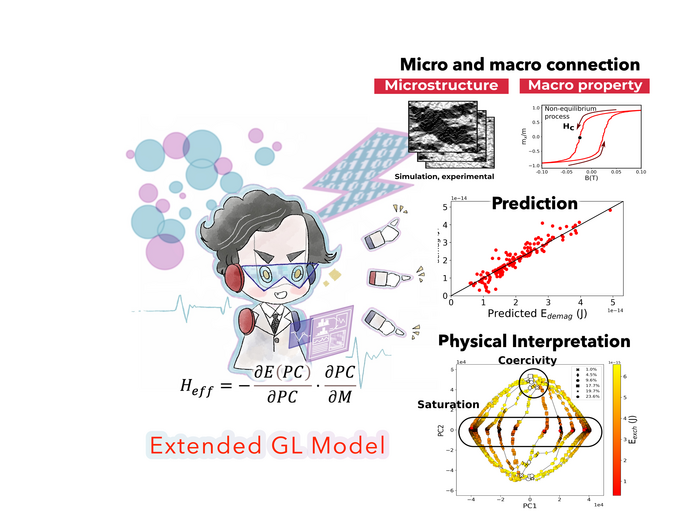Soft magnetic materials, i.e., materials that can be easily magnetized and demagnetized, play an essential role in transformers, generators, and motors. The ability of a magnetic material to resist an external magnetic field without changing its magnetization is known as “coercivity,” a property closely linked to the energy loss. In applications such as electric cars, low-coercivity materials are highly desirable to achieve higher energy efficiency.

Credit: Kotsugi Laboratory from Tokyo University of Science, Japan.
Soft magnetic materials, i.e., materials that can be easily magnetized and demagnetized, play an essential role in transformers, generators, and motors. The ability of a magnetic material to resist an external magnetic field without changing its magnetization is known as “coercivity,” a property closely linked to the energy loss. In applications such as electric cars, low-coercivity materials are highly desirable to achieve higher energy efficiency.
However, coercivity and other magnetic phenomena associated with energy losses in soft magnetic materials originate from very complex interactions. The usual macroscale analysis suffer from oversimplification of the material’s structure and they often need additional parameters to adjust the theory to the experiment. Thus far, although the tools and frameworks to analyze coercivity are widely available, they mostly do not consider directly the defects and boundaries in the material, which is fundamental to develop new applications.
Against this backdrop, a research team including Prof. Masato Kotsugi from Tokyo University of Science (TUS), Japan, recently developed a new approach to connect the microscale characteristics to a macroscopic physical property, coercivity, using a combination of data science, machine learning, and an extension of the GL model. This study, led by Dr. Alexandre Lira Foggiatto from TUS, was published in Communications Physics on 8 November 2022.
The team aimed to find a way to automate the coercivity analysis of magnetic materials while accounting for their microstructural characteristics. To this end, they first gathered data for both simulated and real magnetic materials in the form of microscopic images of their magnetic domains. The images, after preprocessing, were used as input for a machine learning technique called principal component analysis (PCA), which is commonly used to analyze large datasets. Through PCA, the team condensed the most relevant information (features) in these preprocessed images into a two-dimensional “feature space.”
This approach, combined with others machine learning techniques, such as artificial neural networks, allowed the researchers to visualize a realistic energy landscape of magnetization reversal in the material within the feature space. A careful comparison of the results for experimental and simulated images demonstrated the proposed methodology to be a convenient strategy for mapping the most important features of the material in a meaningful way. “Describing the energy landscape using machine learning showed good results for both experimental and simulated data. Both shared similar shapes as well as similar explanatory variables and correlations between them,” remarks Dr. Foggiatto.
Overall, this study showcases how materials informatics can be cleverly leveraged to not only automate but also clarify the physical origin of coercivity in soft magnetic materials. With any luck, it will help materials scientists and physicists derive new physical laws and models to go beyond the state-of-the-art models and frameworks. Moreover, the applications of this strategy go well beyond coercivity, as Dr. Foggiatto highlights: “Our method can be extended to other systems for analyzing properties such as temperature and strain/stress, as well as the dynamics of high-speed magnetization reversal processes.”
Interestingly, this is the second study Prof. Masato Kotsugi and his colleagues have published in relation to the extended Landau free-energy model they are developing. They hope that, in the near future, their functional analysis models will help achieve high efficiency in electric car motors, paving the way to more sustainable transportation.
***
Reference
DOI: https://doi.org/10.1038/s42005-022-01054-3
About The Tokyo University of Science
Tokyo University of Science (TUS) is a well-known and respected university, and the largest science-specialized private research university in Japan, with four campuses in central Tokyo and its suburbs and in Hokkaido. Established in 1881, the university has continually contributed to Japan’s development in science through inculcating the love for science in researchers, technicians, and educators.
With a mission of “Creating science and technology for the harmonious development of nature, human beings, and society,” TUS has undertaken a wide range of research from basic to applied science. TUS has embraced a multidisciplinary approach to research and undertaken intensive study in some of today’s most vital fields. TUS is a meritocracy where the best in science is recognized and nurtured. It is the only private university in Japan that has produced a Nobel Prize winner and the only private university in Asia to produce Nobel Prize winners within the natural sciences field.
Website: https://www.tus.ac.jp/en/mediarelations/
About Professor Masato Kotsugi from Tokyo University of Science
Dr. Masato Kotsugi graduated from Sophia University, Japan, in 1996 and then received a Ph.D. from the Graduate School of Engineering Science at Osaka University, Japan in 2001. He joined the Tokyo University of Science in 2015 as a lecturer and is currently a Professor at the Faculty of Advanced Engineering, Department of Materials Science and Technology. Prof. Kotsugi and his students conduct cutting-edge research on high-performance materials to create a green energy society. He has published over 127 refereed papers and is currently interested in solid-state physics, magnetism, synchrotron radiation, and materials informatics. He can be reached at: [email protected]
Funding information
This study was partly supported by JSPS Grant-in-Aid for Scientific Research (A) number 21H04656.
Journal
Communications Physics
DOI
10.1038/s42005-022-01054-3
Method of Research
Experimental study
Subject of Research
Not applicable
Article Title
Feature Extended Energy Landscape Model for Interpreting Coercivity Mechanism
Article Publication Date
8-Nov-2022
COI Statement
The authors declare no competing interests.




